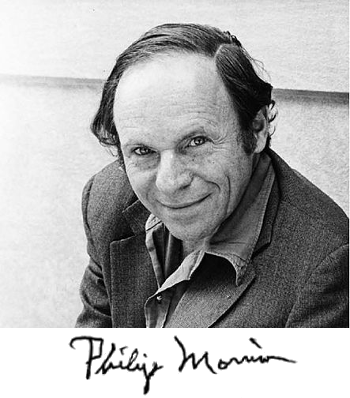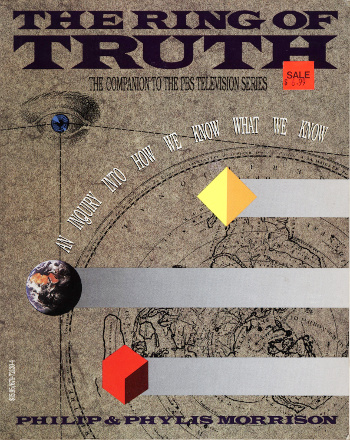Philip Morrison
March 24, 2016
The expression, "clear as a
bell," is a popular
idiom. There's something about the
anharmonic timbre of a bell that catches one's attention. That's why
town criers, the
news announcers of yesteryear, used a bell to signal their presence; why an
electromechanical bell was used for nearly a
century as an attention-getter on
telephones; and why
churches use bells to summon
worshipers.
Another idiom about bells is the idea of something "ringing true." A bell rings true when it's
tuned to its correct
pitch. From this idea we get the concept that an explanation that rings true is an explanation that's correct or believable. An explanation that your
dog ate your
homework doesn't ring true if the
teacher knows that you don't have a dog. That's why younger
siblings are at times useful.
When a
scientist hits upon a particularly beautiful way to explain an
experiment or an
observation, he says that his
theory has "the ring of truth." The Ring of Truth was the title of six-part series of
physics-themed
television shows aired on
public television in 1987 and its accompanying
book.[1-2] These were
authored by the preeminent
physicist,
Philip Morrison, and his
wife, Phylis.

Physicist, Philip Morrison (November 7, 1915 – April 22, 2005), as shown in a 1976 photo.
(NASA photo of Philip Morrison and his signature, via Wikimedia Commons.)
Morrison is one of the few physicists to have his own page on the
Internet Movie Database (IMDb)[3] (some others being
Carl Sagan[4] and
Stephen Hawking[5]). Morrison's first didactic film piece was a short 1972 documentary on the mechanism of the
Polaroid SX-70 instant camera.[6] His last film appearance was in a
2002 documentary about the
Manhattan Project.[7]

The cover of "The Ring of Truth" by Philip Morrison and Phylis Morrison.
This book was first published in October, 1987. I purchased my copy for $6.99.
(Scan of my copy)
Morrison's appearance on this Manhattan Project documentary was a consequence of his having been both long-lived, and one of the youngest members of the Project team. This was a consequence of his being a
student of
Robert Oppenheimer at the
University of California, Berkeley, and obtaining his physics
Ph.D. in 1940. He started work on the Manhattan Project with
Eugene Wigner at the
The University of Chicago in 1942, but moved to Oppenheimer's
Los Alamos laboratory in 1944 to work on the
explosive lens design. He also
calculated the
mass of
plutonium needed for a
bomb.[8]
Morrison was born in
Somerville, New Jersey, just a half-hour's drive from
Tikalon's home base. His
family moved to
Pittsburgh when he was two, hence his enrollment at local
Carnegie Tech. Morrison was originally interested in
electrical engineering, but he switched to physics, getting his
B.S. degree in 1936. From age four, as a consequence of contracting
polio, Morrison needed to wear a
brace on one
leg.[8]
World War II is known as the "
physicist's war," but physicists continued with a different war after 1945, when it appeared that
governments had become too enamored with their new
weapon of mass destruction. As Robert Oppenheimer expressed it, it was also an
atonement for their "
sin."[9] Morrison became an advocate for
nuclear nonproliferation, helping to found the
Federation of American Scientists and writing articles for the
Bulletin of the Atomic Scientists.
The
United States just after World War II was a different place than it is today. Morrison's anti-nuclear weapons efforts earned him a place in
Life magazine's 1949 gallery of "America's 50 most eminent
dupes and fellow travellers."[8] Adding to his troubles, he was a member of three groups that were added to a list, created by the
US Attorney General, of allegedly
subversive organizations.[8] Morrison was a
professor at
Cornell University (Ithaca, New York) at the time, and with the help of Cornell
colleague,
Hans Bethe, he was able to keep his university position, but only after curtailing his public
political activities.[8]
Morisson's
research interests changed from
nuclear physics to
astrophysics in the
1950s. One of his last nuclear physics projects was co-authoring the 1952
textbook, "Elementary Nuclear Physics," with Bethe. His move away from nuclear physics was seen as his rejection of the government
bureaucracy that's an essential part of "
Big Science."[8] Morrison joined the faculty of the
Massachusetts Institute of Technology in 1964, where he eventually attained the rank of Institute Professor. The title of Institute Professor is explained as follows in his MIT
obituary.[10]
"The title is reserved for those who have demonstrated exceptional distinction by a combination of leadership, accomplishment and service in the scholarly, educational and general intellectual life of the Institute or wider community."
Morrison's paper, "On gamma-ray astronomy," appeared in
Il Nuovo Cimento in 1958, and it's considered the start of
gamma ray astronomy.[11] He co-authored on early paper on
SETI with
Giuseppe Cocconi.[12] Morrison summarized his opinion on SETI as follows:
"The probability of success is difficult to estimate, but if we never search, the chance of success is zero."[8]
Morrison co-authored a 1963 paper with James Felten, one of his students, on the importance of the
inverse Compton effect on the origin of
high energy cosmic radiation.[8] With his first wife, Emily, he authored a 1956 book on
Charles Babbage.[13] As a
high school student, I learned physics from the 1962
Physical Science Study Committee (PSSC) textbook,
Physics, containing several sections authored by Morrison.[8] Morrison was responsible for nearly 1500
book reviews in
Scientific American.[8] I don't think that I've read that many books in my lifetime; but, perhaps, the
Internet is to blame for that.
Morrison was
chairman of the
Federation of American Scientists from 1973 to 1976, a
fellow of the
American Physical Society, a member of the
National Academy of Sciences, and the
International Astronomical Union, among other organizations. Among his many awards, Morrison was the recipient of the
American Association for the Advancement of Science Westinghouse Science Writing Award, the
American Institute of Physics Andrew Gemant Award, and the
Astronomical Society of the Pacific Klumpke-Roberts Award.[8]
One interesting Morrison
anecdote involves his work on the Manhattan Project. He carried the
plutonium core of the
Trinity test bomb in his lap in its transit from Los Alamos to the
Alamogordo test site. He said that the "core felt slightly warm, like a small
cat."[8] Such
radioisotope generators have now progressed from lap warmers to
power supplies for
spacecraft to Pluto.
References:
- Video clips from "The Ring of Truth" series by Philip and Phylis Morrison, YouTube, April 21, 2014.
- Philip Morrison and Phylis Morrison, "The Ring of Truth: An Inquiry into How We Know What We Know," Random House, October 12, 1987, 307 pp., ISBN-13, 978-0394556635 (via Amazon).
- Philip Morrison on the Internet Movie Database.
- Carl Sagan on the Internet Movie Database.
- Stephen Hawking on the Internet Movie Database.
- SX-70 (Documentary, 1972) on the Internet Movie Database.
- The Manhattan Project, Modern Marvels, Season 8, Episode 20 (June 4, 2002). Listed as Season 9, Episode 21 on Wikipedia.
- Leo Sartori and Kosta Tsipis, "Philip Morrison 1915—2005, A Biographical Memoir," National Academy Of Sciences, 2009 (0.5 MB PDF File).
- J. R. Oppenheimer, "Physics in the Contemporary World," Bulletin of the Atomic Scientists, vol. 4, no. 3 (March, 1948), p. 66, as quoted in James A. Hijiya, "The Gita of J. Robert Oppenheimer," Proceedings of The American Philosophical Society, vol. 144, no. 2 (June, 2000), p. 128.
- Elizabeth A. Thomson, "Institute Professor Philip Morrison dies at 89," MIT Press Release, April 25, 2005.
- P. Morrison, "On gamma-ray astronomy," Il Nuovo Cimento, vol. 7, no. 6 (March, 1958), pp 858-865.
- P. Morrison and G. Cocconi, "Searching for interstellar communication," Nature, vol. 185, no. 4690 (September 19, 1959), pp. 844-846.
- Philip Morrison and Emily Morrison, "Charles Babbage and His Calculating Engines," Dover Publications (1961), 400 pp., ISBN-13, 978-0486200125 (Via Amazon).
Permanent Link to this article
Linked Keywords: Bell; idiom; anharmonicity; anharmonic; timbre; town crier; news presenter; news announcer; electromechanics; electromechanical; century; telephone; church; worshiper; musical tuning; tuned; pitch; dog; homework; teacher; sibling; scientist; experiment; observation; theory; physics; television program; television show; public broadcasting; public television; book; author; authored; physicist; Philip Morrison; wife; NASA; signature; Wikimedia Commons; Internet Movie Database (IMDb); Carl Sagan; Stephen Hawking; Polaroid SX-70; instant camera; Modern Marvels 2002 documentary; Manhattan Project; postgraduate education; graduate student; J. Robert Oppenheimer; University of California, Berkeley; Doctor of Philosophy; Ph.D.; Eugene Wigner; The University of Chicago; Los Alamos laboratory; explosive lens; calculation; calculated; mass; plutonium; nuclear weapon; bomb; Somerville, New Jersey; Tikalon; family; Pittsburgh; Carnegie Mellon University; Carnegie Tech; electrical engineering; Bachelor of Science; B.S. degree; poliomyelitis; polio; orthotics; brace; human leg; World War II; physicist's war; government; weapon of mass destruction; atonement; sin; nuclear nonproliferation; Federation of American Scientists; Bulletin of the Atomic Scientists; United States; Life magazine; dupe; US Attorney General; subversion; subversive; professor; Cornell University (Ithaca, New York); colleague; Hans Bethe; politics; political; research; nuclear physics; astrophysics; 1950s; textbook; bureaucracy; Big Science; Massachusetts Institute of Technology; obituary; Il Nuovo Cimento; gamma ray astronomy; Search for extraterrestrial intelligence; SETI; Giuseppe Cocconi; probability; estimate; inverse Compton effect; high energy cosmic radiation; Charles Babbage; high school student; Physical Science Study Committee; PSSC; book review; Scientific American; Internet; chairman; fellow; American Physical Society; National Academy of Sciences; International Astronomical Union; American Association for the Advancement of Science; Westinghouse Science Writing Award; American Institute of Physics; Andrew Gemant Award; Astronomical Society of the Pacific; Klumpke-Roberts Award; anecdote; pit; plutonium core; Trinity test; Alamogordo, New Mexico; cat; radioisotope thermoelectric generator; power supply; New Horizons; spacecraft to Pluto; Philip Morrison and Phylis Morrison, "The Ring of Truth: An Inquiry into How We Know What We Know," Random House, October 12, 1987, 307 pp., ISBN-13, 978-0394556635.